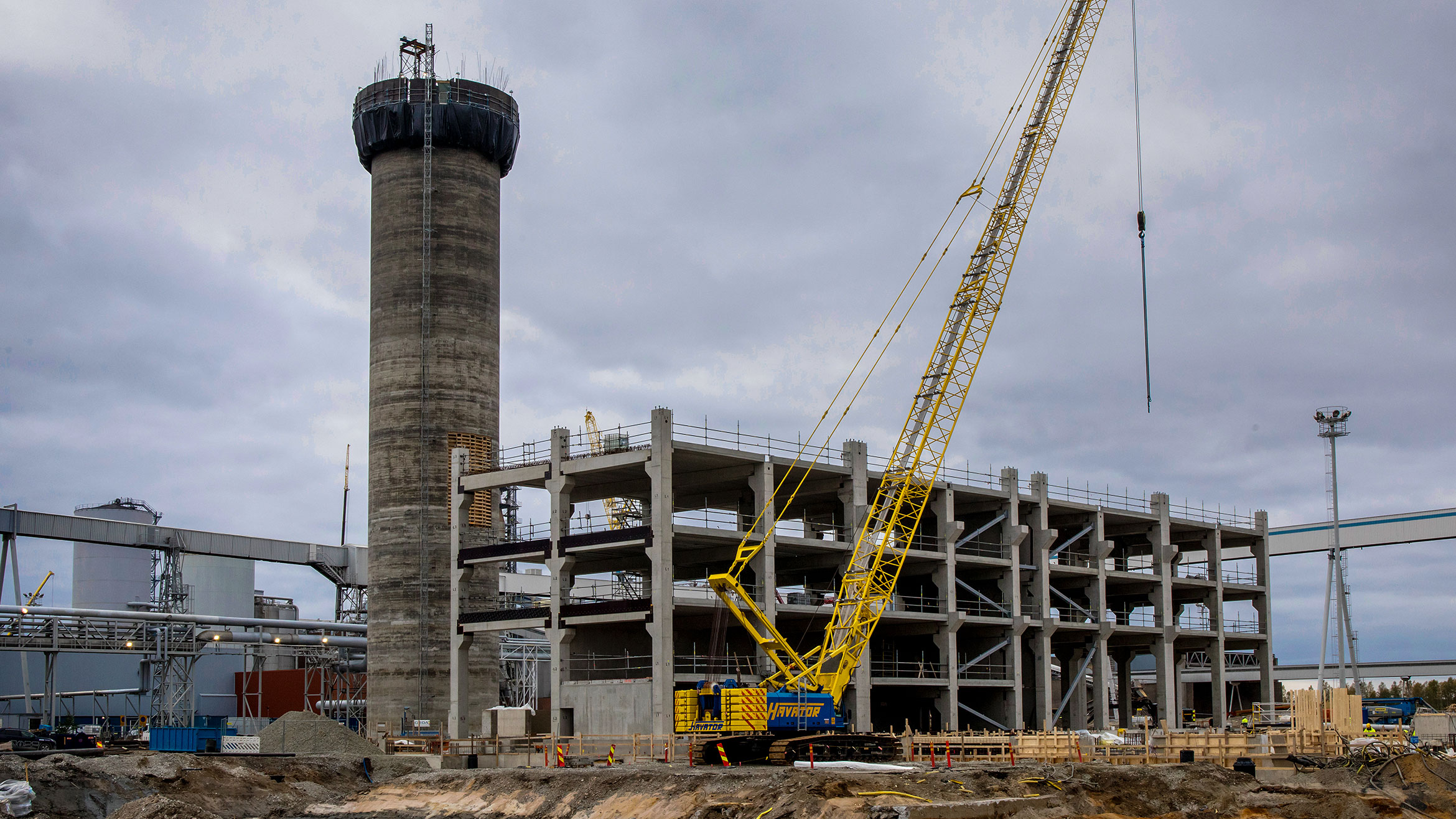The two main elements for Metsä Fibre’s new bioproduct mill in Kemi are environmental and resource efficiency. Based on our unique bioproduct mill concept, it represents the next development step in environmental efficiency.
“Resource efficiency means that we get an optimal yield from wood, in terms of the volume of bioproducts obtained, and that we use chemicals, water and energy as efficiently as possible in production,” says Kaija Pehu-Lehtonen, Senior Vice President, Business Development.
The core idea of our bioproduct mill concept is to fully utilise wood and production side streams for pulp, other bioproducts and bioenergy that can replace fossil-based materials and fuels. Energy self-sufficiency and a water cycle that is as closed as possible are also essential elements in the concept.
“Our processes must allow nothing to go to waste. This means recovering valuable wood fibres for pulp and using the remaining parts as efficiently as possible for other material purposes,” says Pehu-Lehtonen.
Any parts that are not suitable as material will be used as renewable energy to provide power to energy efficient production processes.
Continuously evolving concept
Metsä Fibre is using the unique bioproduct mill concept to renew its pulp mills. The concept emerged in the early 2010s, as the company considered various options for replacing the old Äänekoski pulp mill, then nearing the end of its life-cycle.
Äänekoski bioproduct mill, constructed in accordance with the new concept, was started up in 2017. Kemi bioproduct mill, now under construction, will further develop the concept.
“Every time we build a new mill, we can make improvements to its unit processes, thanks to improved technology. In Kemi, we can use features that were not yet available to us in Äänekoski. There are also new by-product opportunities,” says Pehu-Lehtonen.
She believes the main changes will enhance the bioproduct mill’s energy and material efficiency. This will also bring new improvements to the new mill’s environmental performance.
“We follow environmental performance by monitoring water and energy use, material efficiency, traditional emissions indicators, and so on. The principle of continuous improvement is vital. It forms the basis of our operations.”
“Technology continues to develop, and we understand interactions better than ever. However, closed cycles lead to the accumulation of elements, so we must find new ways to use them.”
Pehu-Lehtonen still sees room for improvement, even though emissions from the Äänekoski bioproduct mill are very low – and the Kemi mill will emit even less.
“We must set high targets for ourselves. We have continued to reduce the volume of water going to the wastewater treatment plant, but our goal is to build a path at the bioproduct mill that will enable us to eliminate wastewater emissions altogether.”
Metsä Fibre is well placed to be a front runner, she says, with a bioproduct mill that refines renewable material using advanced and environmentally sustainable technology.
“This is also important to our customers. By complying with the principles of sustainability and continuing to develop our operations, we can provide clear added value to their business operations.”
Sustainable use of renewable resources
Wood is a renewable resource, and its uses are much discussed. The pulpwood used at the bioproduct mill, which is often obtained from first thinning, is part of sustainable forest management. Pehu-Lehtonen emphasises the importance of using wood sustainably.
“We can use renewable resources to produce renewable products and solutions that replace products made of fossil-based materials. In addition, the entire production process must be sustainable.”
Metsä Fibre’s sawmills that use logs are also essential to the concept. The wood chips that sawmills produce as a side stream are used in pulp production. Every part of the tree can be used sustainably and resource-efficiently.

Closed chemical cycles for a circular economy
The pulp production process has a closed cycle of cooking chemicals, meaning that the chemicals are regenerated for reuse in the pulp mill cycle. Components that dissolve from wood are recovered during the process and used for biochemicals such as tall oil and turpentine.
This also reduces the load on the wastewater treatment plant. Flue gases are purified by converting odorous process gases into sulphuric acid, which is needed when cooking tall oil.
“Closed chemical cycles are prime examples of the circular economy. We recover chemicals in the process and use them to produce chemicals needed in another process,” Pehu-Lehtonen says.
Closed cycles also improve cost-effectiveness. For example, less energy is required for pumping water if the volume of fresh water used in the processes has been minimised.
The portion that cannot be used for materials or chemicals is consumed as energy by the mill itself and the surrounding integrated mill area. Production at the bioproduct mill is energy self-sufficient and uses renewable sources, with no fossil fuels.
“Secondary heat from the bioproduct mill process is used as efficiently as possible in the integrated mill area. For example, at Kemi, we must make sure that the thermal load on waterways does not increase in the winter.”
Heat is also recovered from flue gases. For example, secondary heat is used in bark drying, when the bark is gasified and used as fuel.
The Kemi bioproduct mill will have an energy self-sufficiency rate of 250 per cent. The surplus power, produced from renewable resources, will be sold to the Finnish national power grid.
A company ecosystem for products and processes
In the bioproduct mill concept, partner companies located nearby, as well as the ecosystem formed by the mill and its partners, enable side streams to be utilised and processed on-site.
The business ecosystem develops gradually and may continue to expand long into the future. At Kemi, just as at Äänekoski, the bioproduct mill forms an ecosystem core that is expected to attract more bioproduct-related pilot projects and new players in and around the mill.
Metsä Board already has a paperboard mill operating in the same integrated unit as the new Kemi bioproduct mill. The Äänekoski bioproduct mill also has a Metsä Board paperboard mill next door. At Äänekoski, the mill area is home to a textile fibre demo plant and a demo plant for 3D fibre products. There are plans to set up a methanol purification facility in the area.
“In the future, the ecosystem may be joined by entirely new operators that convert pulp or side streams on-site. Kemi is just getting started, but operations there can benefit from experience gained at Äänekoski.”
Of the possible new concepts emerging at Kemi, Pehu-Lehtonen sees interesting opportunities related to carbon dioxide.
“Carbon dioxide can be used as a feedstock for chemicals or as an energy store. Since it originates from a renewable resource, it might be a good source of raw materials for future energy production.”
In the future, bark will also be refined into products instead of using it as an energy source in place of fossil fuels. Metsä Fibre is exploring this topic in collaboration with universities and research institutes.
“Bark can be used for various energy products. We have also studied the separation of tannins and, in collaboration with steel companies, looked at whether bark could be used as a raw material for coke. It ultimately depends on the interests of the upgrading chain.”
This article was originally published in Fibre Magazine issue 2021-2022.

